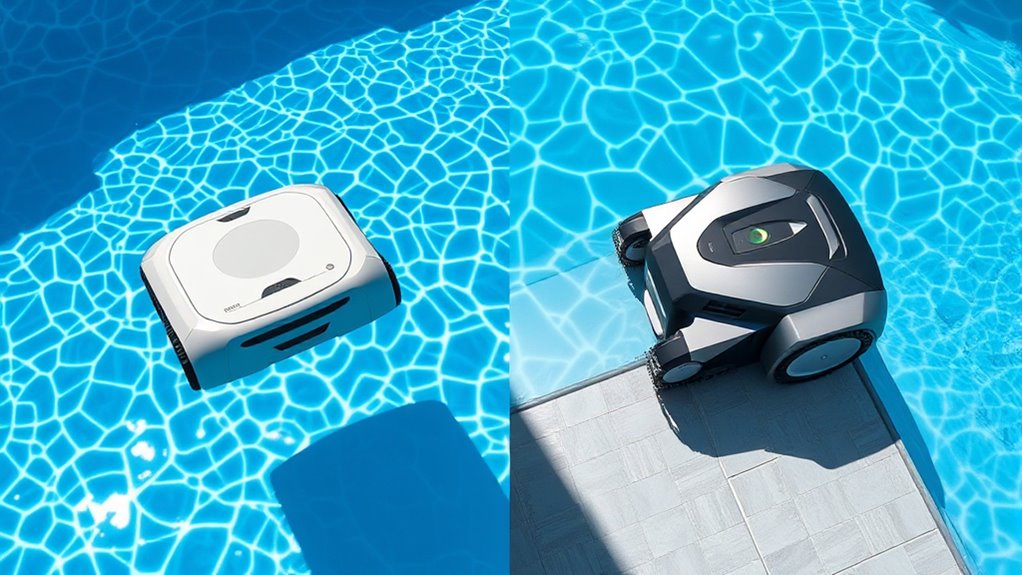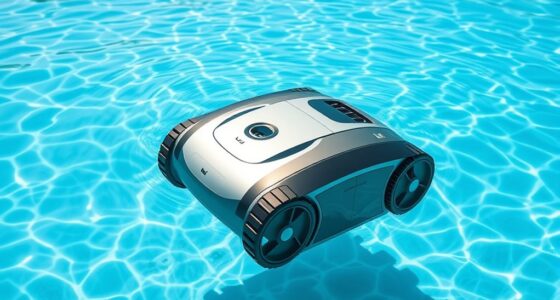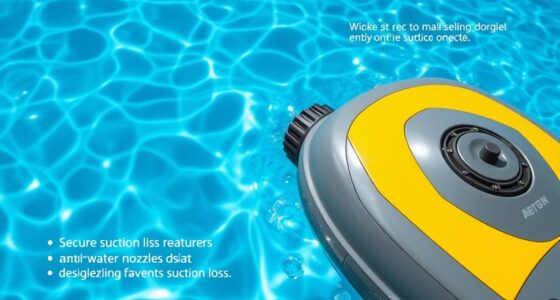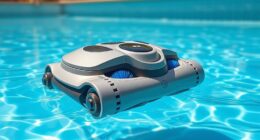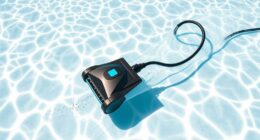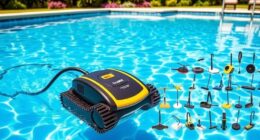When choosing robotic pool cleaners, size and design matter. Above-ground pool models are smaller and more streamlined for easy handling and fitting tight spaces, while in-ground models are larger to cover bigger surfaces efficiently. Performance features like customizable cycles and sensors adapt to different pool shapes and materials. Budget and maintenance needs also vary, so understanding your pool type helps you pick the best option. Keep exploring to discover which model suits your pool best.
Key Takeaways
- In-ground pool cleaners are larger and more powerful, suitable for extensive surfaces and complex shapes, while above-ground models are smaller and more streamlined.
- Compatibility varies; in-ground cleaners work well with larger, irregular pools, whereas above-ground units are designed for simpler, smaller pools.
- In-ground robotic cleaners often feature advanced navigation and sensors for thorough coverage, unlike basic models for above-ground pools.
- Budget and long-term costs differ, with in-ground cleaners generally being more expensive but offering higher efficiency and durability.
- Installation and maintenance are typically more complex for in-ground models, while above-ground cleaners are easier to set up and maintain.
Differences in Size and Design
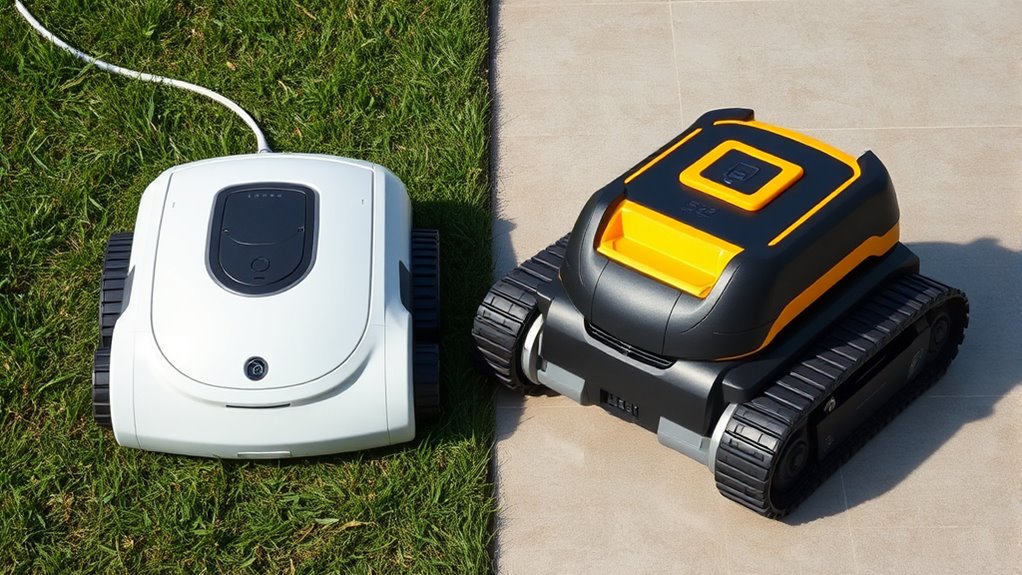
Robotic pool cleaners come in a variety of sizes and designs to suit different pool types and cleaning needs. When choosing one, consider how its size can impact pool aesthetics, especially in above-ground pools where a bulky unit might be an eyesore. Smaller, streamlined models blend seamlessly with your pool’s look, enhancing overall aesthetics. Design also affects user convenience; compact models are easier to handle, transport, and store, making routine cleaning less of a hassle. Larger units might cover more ground quickly but can be cumbersome to maneuver. The right size and design assure your pool stays visually appealing and maintenance remains straightforward. Utilize vertical storage solutions to keep your equipment organized and out of sight, further enhancing pool area aesthetics. By selecting a model tailored to your pool’s shape and your preferences, you improve both aesthetics and convenience. Additionally, compact designs often feature improved maneuverability, allowing for more effective cleaning in tight corners or irregularly shaped pools. Moreover, understanding pool size and shape can help you choose the most suitable cleaner and optimize its performance, ensuring efficient and thorough cleaning. Considering cleaning efficiency can also help you select a model that minimizes energy consumption and maximizes cleaning results.
Performance and Cleaning Capabilities
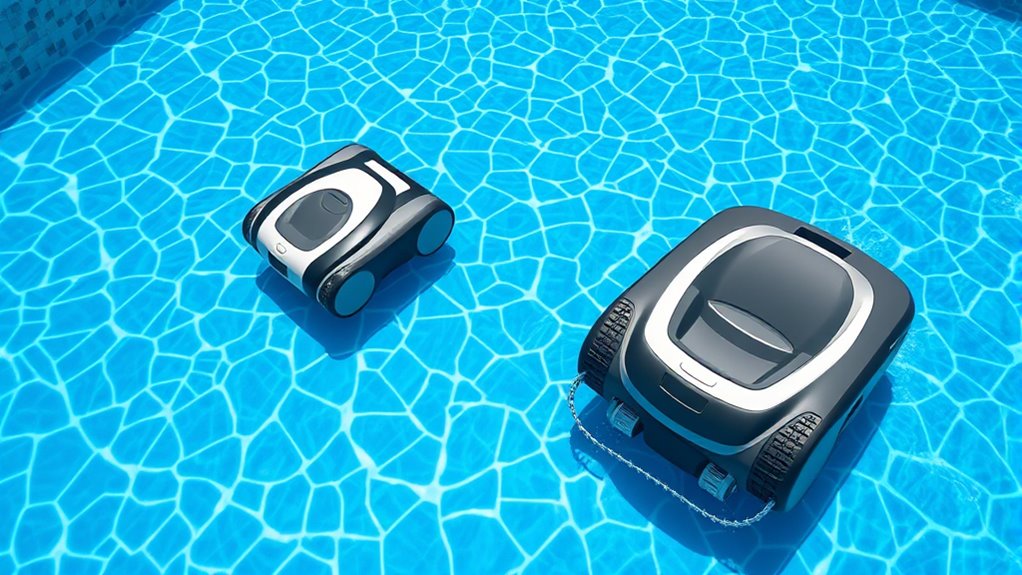
When evaluating robotic pool cleaners, their performance and cleaning capabilities are crucial factors to consider. You’ll want a model with effective robotic navigation to ensure thorough coverage of your pool’s surfaces. A good cleaner will have customizable cleaning cycles, allowing you to choose between quick or detailed cleanings based on your needs. Look for devices that can handle debris, dirt, and algae, providing consistent suction and scrubbing power. Efficient cleaning cycles minimize energy use while maximizing cleanliness. Some models are equipped with advanced sensors to detect dirty areas and adjust their path accordingly, saving you time and effort. Additionally, noise levels of the robotic pool cleaner can impact your outdoor environment and overall experience. Choosing a model with user-friendly controls can further enhance ease of operation and maintenance. Moreover, selecting a device with energy-efficient operation can help reduce your pool cleaning costs over time. Incorporating advanced filtration systems can also improve cleaning effectiveness and extend the lifespan of your pool equipment. Overall, a robot with strong performance and versatile cleaning capabilities ensures your pool stays pristine with minimal manual intervention.
Compatibility With Pool Types and Shapes
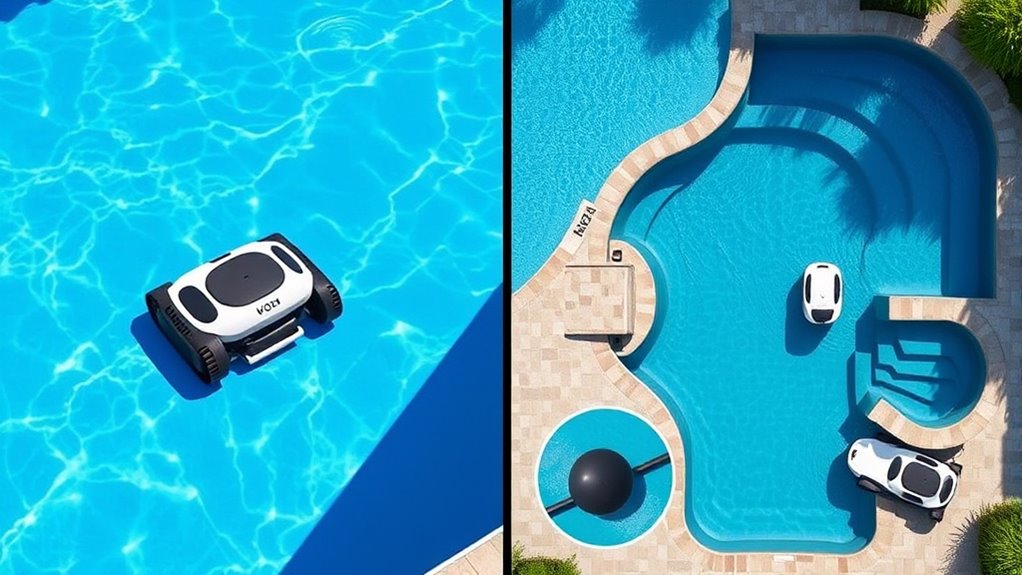
Choosing a pool cleaner that’s compatible with your specific pool type and shape is essential for effective cleaning. Different pool materials, like concrete, vinyl, or fiberglass, can affect how well a robotic cleaner works. Some models are designed specifically for in-ground pools, with features that handle larger surfaces and complex shapes, while others suit above-ground pools better. The shape of your pool—round, oval, or irregular—also impacts which cleaner will deliver the best user experience. A compatible cleaner navigates smoothly over your pool’s walls and floor without getting stuck, ensuring thorough coverage. Understanding pool surface materials can help you select a model that minimizes wear and tear on your pool. Additionally, considering pool size and depth can influence the type of cleaner that will perform best for your specific needs. Incorporating sensor technology can help the cleaner detect obstacles and optimize cleaning paths, saving time and energy. Moreover, advancements in robotic navigation systems have increased the efficiency of pool cleaners, allowing them to adapt better to various pool configurations. When you select the right model, you’ll enjoy easier maintenance, fewer frustrations, and better overall results, regardless of your pool’s material or shape.
Budget Considerations and Cost-Effectiveness

Budget considerations play a crucial role in selecting the right robotic pool cleaner, as prices can vary markedly based on features and quality. When comparing costs, consider the initial investment versus long term savings. A higher-priced model may seem costly upfront but often offers better efficiency, durability, and energy savings, reducing ongoing maintenance expenses. Conduct a thorough cost comparison to evaluate which cleaner provides the best value for your pool size and type. Cheaper models might save money initially but could require frequent repairs or replacements, increasing overall costs. Investing in a reliable, energy-efficient cleaner can lead to significant long term savings by minimizing manual cleaning time and lowering energy bills. Additionally, understanding energy efficiency can help you choose a model that reduces operating costs over time. Recognizing the impact of long-term savings can guide you toward a more economical choice overall. Ultimately, balancing upfront costs with potential savings ensures you make a smart, cost-effective choice.
Installation and Maintenance Requirements
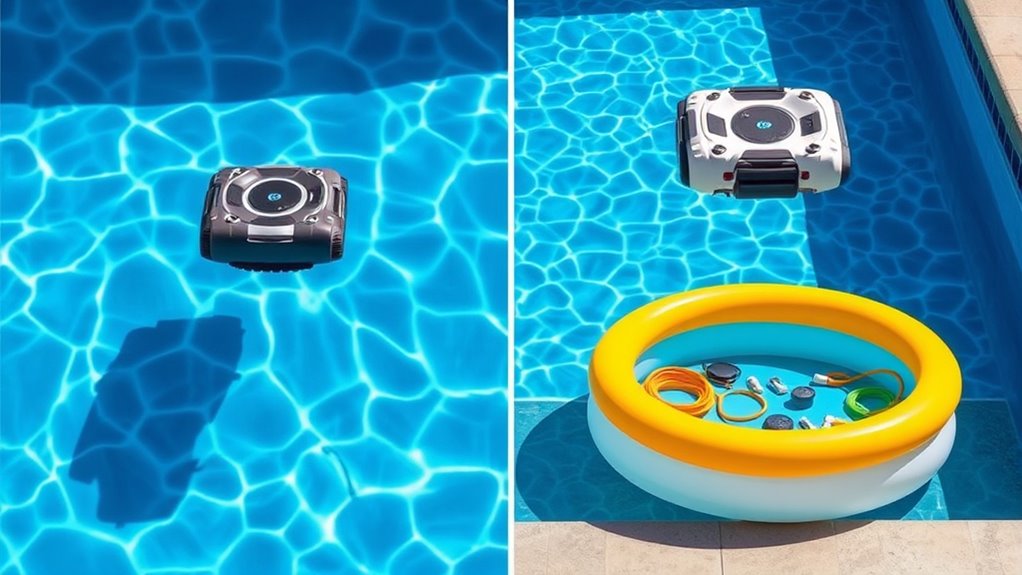
Installing a robotic pool cleaner is generally straightforward, but it’s vital to follow the manufacturer’s instructions carefully to guarantee peak performance. Regular maintenance includes cleaning filters, inspecting cables, and checking for debris. Some models require manual operation for setup or occasional cleaning, so make sure you understand how to operate the unit properly. Electrical safety is essential; always disconnect power during maintenance and avoid exposing the unit to water when unplugged. It’s also important to monitor the proper operation of the device to prevent malfunctions or damage. Additionally, ensuring adequate filtration system functioning can help prolong the lifespan of your cleaner and maintain optimal cleaning efficiency. Proper installation procedures are crucial for successful integration with your pool’s existing systems. Regularly reviewing manufacturer’s guidelines can help ensure safe and effective usage. Here’s a quick overview:
| Maintenance Tasks | Frequency |
|---|---|
| Clean filters | After every use |
| Inspect cables | Weekly |
| Check for debris | Before and after use |
Frequently Asked Questions
Can Robotic Pool Cleaners Be Used in Saltwater Pools?
Yes, robotic pool cleaners can be used in saltwater pools. Look for models with saltwater compatibility and corrosion resistance, as these features guarantee durability and effective cleaning. Saltwater pools can be harsher on equipment, so choosing a cleaner designed to handle the salt’s corrosive effects safeguards your investment. Regular maintenance and choosing a suitable robotic cleaner will keep your pool pristine without worries about corrosion or damage.
Do Robotic Cleaners Work Effectively With Pool Covers?
Imagine your pool, hidden beneath a cover, waiting to be pristine. Robotic cleaners struggle with pool cover compatibility; they can’t access the water or debris underneath effectively. Debris removal efficiency drops considerably when a cover is in place, making these robots less effective. For ideal cleaning, remove the cover first. Otherwise, you’ll find your robotic cleaner wasting time, unable to do its job, leaving your pool less than sparkling.
How Long Do Robotic Pool Cleaners Typically Last?
Robotic pool cleaners typically last around 3 to 8 years, depending on maintenance frequency and usage. Properly maintaining your cleaner, like cleaning filters and checking for wear, can extend its battery lifespan and overall durability. Regular upkeep ensures peak performance and helps you avoid early replacements. Keep an eye on battery health and address minor issues promptly to maximize your cleaner’s lifespan and get the most value out of your investment.
Are There Safety Features for Children and Pets?
You’ll find many robotic pool cleaners include child safety and pet protection features, like automatic shut-off when lifted or separated from water. These safety features help prevent accidents and keep curious kids and pets safe around your pool. Always check the product details to guarantee it has such features, giving you peace of mind while your cleaner operates, and making your pool area safer for everyone.
Can Robotic Cleaners Handle Debris Like Leaves and Twigs?
Robotic pool cleaners excel at leaf removal and twigs cleaning, making pool maintenance easier. They’re designed to pick up larger debris like leaves and twigs quickly and efficiently, saving you time and effort. Thanks to their powerful suction and brushes, they can handle most outdoor debris, ensuring your pool stays clean. Just make sure to choose a model with a suitable debris capacity for ideal leaf removal and twigs cleaning.
Conclusion
Choosing between robotic pool cleaners for above-ground and in-ground pools depends on your needs. While above-ground models tend to be more affordable and simple to maintain, in-ground options offer advanced features and thorough cleaning. It’s a balance between cost and performance. Sometimes, the cheaper, easier option suffices; other times, investing in a more robust system pays off. Ultimately, your pool type and budget shape your ideal choice—making the decision clear once you weigh the differences.
